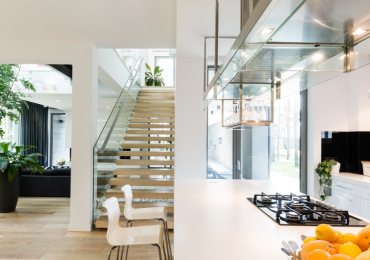In conversation with archibrix founder Davor Bagarić
Every beginning is time-consuming. This is why it is all the more important for us to get to know our online platform archibrix better. We see ourselves as a link between architects on the one hand and project developers, property developers, and private clients on the other. On the one hand, architectural 3D designs can be monetized excellently on our online platform. and on the other hand, buyers can save a lot of time with our service. With this interview, we would like to take a closer look at the topic of house construction and the archibrix project. We will discuss the benefits and the target groups of archibrix and point out the opportunities that this opens up for all stakeholders involved. Finally, we will take a look at the near future of the online platform.
The virtual architect
Who would be better suited for such a project than our founder Davor Bagarić. After all, he was the one who finally had a brilliant idea for it. So, on a warm late summer’s day, we came together to elicit all the information about archibrix from our founder.
What is behind the online platform archibrix?
Archibrix is a Proptech start-up founded in 2019 in Zagreb, Croatia. Archibrix can be imagined as a kind of virtual architect. In the form of a marketplace, it brings together architects, designers, and builders on an online platform, whether they are private individuals who want to build a single-family home, or developers and real estate project developers who are planning houses with several apartments or buildings with several office units. As with a classic marketplace, the buyer selects the appropriate design based on his criteria and can purchase it at an attractive license price. The purchase includes both the creative work of the architect and the rights of use, as well as the physical design in the form of a CAD file, which can be worked on further.
Is there a story about archibrix? What was the brilliant idea behind it?
Our circle of friends consists primarily of architects and technical draftsmen. In general, independent architects very often take part in competitions or have an idea of a building that is perfectly defined for a certain target group. Competitions are extremely time-consuming processes, as the concepts and designs for submission are very detailed. Usually, there is a hail of submissions, but at the end of the day, there is only one winner who is awarded the contract. In the end, all these designs submitted in vain end up on the hard disk, the so-called “virtual, dark drawer”. Through numerous discussions with those affected, we have been able to identify a high level of frustration among the architects. The approach of archibrix is to reactivate these concepts, to find suitable building sites and users worldwide.
to find them and make them a reality. “One may imagine it in much the same way as the phoenix rising from the ashes.”
However, Archibrix not only brings rejected ideas back to life but can also become a global springboard for architects and designers. Different concepts for the “Perfect House” can be immediately presented globally for specific target groups with the help of archibrix. If these designs are also optimized to meet different requirements and terrain characteristics, innovative marketing opportunities arise for architects and their ideas and visions.
Who are the target groups of the online platform archibrix?
In principle, this can be anyone who needs a concept for a house or building to be built on a specific plot of land. More concretely, there are two main target groups. On the one hand, as already mentioned, they are architects who provide the content to monetize it with an international mix of audiences. On the other hand, it is builders, i.e. private individuals who want to build a single-family home or property developers and real estate project developers who are constructing buildings with severeal residential or office units.
The business model is that of a classic marketplace. When the designer purchases a design or an adaptation service, a so-called “marketplace fee” is charged. This means that we generate a share of the turnover if the deal is successful.
What advantages does it offer the architect?
The advantages are quite obvious. The architect can now offer his work. Which was thought to have been lost, for sale after all, and thus make use of it. Besides, he can present his ideas regarding quality living space or commercial space to a global audience. Archibrix makes it possible, for example, to easily sell designs and concepts overseas. In other words, an architect from Austria can reach customers in the USA in this way. Our partner offices (civil technicians and engineers) naturally adapt the designs, in the respective countries to the legal and climatic conditions. Besides being an additional source of income. It is also a digital marketing channel where architects can present their portfolio, always in front of an international audience. In the best-case scenario, the architect is then commissioned to make changes to his design to adapt any visual relationships or solar radiation to the property.
What advantages does archibrix offer the purchaser (builder/property developer/project developer)?
The purchaser can be guided by a very large number of designs. This is because concepts and ideas are collected by the most creative architects and designers from around the world and presented on our online platform. Probably the most important aspect for project developers and property developers, however, is the time saved through designs that are already ready for sale.
You start marketing directly from the design, with high-quality visualizations, comprehensibly prepared sales plans, and a convincing portfolio. As a rule, this can save several months of working time! The big advantage for the individual client is that he can choose from a wide range of options to find the perfectly fitting property. Of course, this search algorithm takes into account the plot of land as well as the future use of the building of the client through queried parameters. And of course, the costs are a decisive argument for all buyers, instead of paying 6% of the building sum to the architect, one only has to pay a manageable license fee for the design.
BIM guarantees the highest quality standard. What are the criteria used for quality control?
As already mentioned in the question. We rely completely on technology that can be automated using BIM (Building Information Modeling) for the quality control process. This means for the architect that the 3D model to be uploaded must of course be BIM-compliant.
This allows us to analyze this model technically and qualitatively. Similar to a database, the BIM model is accessed directly to create queries. The system helps to ensure a consistently high standard for the purchaser. On the one hand, it checks whether the model as such has been drawn cleanly. On the other hand, it checks whether everything drawn corresponds to reality. If, for example, an exterior wall is only 3 cm wide, our virtual architect will show this immediately. For example, missing rooms in the building can also be pointed out. If there is no toilet in the building, no window in the living room. or even if the window area is too small and the room is therefore not well lit. our system would consider the planning to be extremely questionable and issue a warning.
Is there a comparable online platform worldwide and therefore serious competition?
Various platforms offer the purchase of 3D models. We in turn specialize in architectural and feasible designs. There are comparable approaches, especially in the Anglo-Saxon world. However, these are mainly aimed at private clients, i.e. everything revolves exclusively around single-family homes. What is essential in our eyes, however, is that none of these solutions rely on BIM to carry out quality controls and thus ensure that work on the models can continue without interruption. This is where we stand out from our competitors.
A look into the future. Will archibrix remains a classic marketplace for architectural designs or are there plans to expand it and if so, which ones?
Our vision goes in the direction of offering the purchaser a completely virtual architect. However, we are by no means displacing the real architect. On the contrary, we want to support the architect by offering a digital service. To help him exploit his sales opportunities through a larger market. Single-family homes are just the beginning, as the journey continues in the direction of residential buildings with several units. through to office buildings, hotels, and resort planning.


